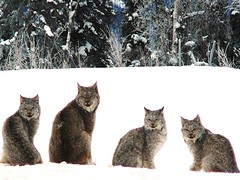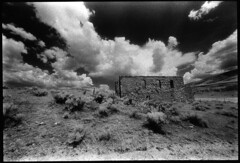Cosma Shalizi
36-402, Undergraduate Advanced Data Analysis
Spring 2015
This is an old version of the class. You are probably looking
for this year's version of the class.
Tuesdays and Thursdays, 10:30--11:50 Wean Hall 7500

The goal of this class is to train you in using statistical models to
analyze data — as data summaries, as predictive instruments, and as tools
for scientific inference. We will build on the theory and applications of the
linear model, introduced
in 36-401,
extending it to more general functional forms, and more general kinds of data,
emphasizing the computation-intensive methods introduced since the 1980s.
After taking the class, when you're faced with a new data-analysis problem, you
should be able to (1) select appropriate methods, (2) use statistical software
to implement them, (3) critically evaluate the resulting statistical models,
and (4) communicate the results of their analyses to collaborators and to
non-statisticians.
During the class, you will do data analyses with existing software, and
write your own simple programs to implement and extend key techniques. You
will also have to write reports about your analyses.
Graduate students from other departments wishing to take this course should
register for it under the number "36-608". Enrollment for 36-608 is very
limited, and by permission of the professor only.
Prerequisites
36-401, or consent of the instructor. The latter is only granted under very unusual circumstances.
Instructors
| Professors | Cosma Shalizi | cshalizi [at] cmu.edu |
| | 229 C Baker Hall |
| Xizhen Cai | xizhen [at] stat.cmu.edu |
| | 232B Baker Hall |
| Teaching assistants | Ms. Dena Asta |
| Mr. Collin Eubanks |
| Mr. Sangwon "Justin" Hyun |
| Ms. Natalie Klein |
Topics, Notes, Readings
- Model evaluation: statistical inference, prediction, and
scientific inference; in-sample and out-of-sample errors, generalization and
over-fitting, cross-validation; evaluating by simulating; the bootstrap;
penalized fitting; mis-specification checks
- Yet More Linear Regression: what is regression, really?;
what ordinary linear regression actually does; what it cannot do; extensions
- Smoothing: kernel smoothing, including local polynomial
regression; splines; additive models; kernel density estimation
- Generalized linear and additive models: logistic
regression; generalized linear models; generalized additive models.
- Latent variables and structured data: principal
components; factor analysis and latent variables; latent cluster/mixture models; graphical models in general
- Causality: graphical causal models; identification of
causal effects from observations; estimation of causal effects;
discovering causal structure; experimental design and analysis
- Dependent data: Markov models for time
series without latent variables; hidden Markov models for time series with
latent variables; longitudinal, spatial and network data
See the end for the current lecture schedule, subject to revision. Lecture notes will be linked there, as available.
Course Mechanics
 Homework will be 60% of the grade, two midterms 10% each, and the final
20%.
Homework will be 60% of the grade, two midterms 10% each, and the final
20%.
Homework
The homework will give you practice in using the techniques you are learning
to analyze data, and to interpret the analyses. There will be twelve weekly
homework assignments, nearly one every week; they will all be due on Mondays at
11:59 pm (i.e., the night before Tuesday classes), through Blackboard. All
homeworks count equally, totaling 60% of your grade. The lowest three homework
grades will be dropped; consequently, no late homework will be accepted for any
reason whatsoever.
Communicating your results to others is as important as getting good results
in the first place. Every homework assignment will require you to write about
that week's data analysis and what you learned from it. This portion of the
assignment will be graded, along with the other questions. As always, raw
computer output and R code is not acceptable; your document must be humanly
readable. We prefer that you submit
an R Markdown
or knitr file, integrating text, figures
and R code; submit both your knitted file and the source. If that is
not feasible, submit a PDF with text and figure, and a separate .R file with
all the commands needed to reproduce your work. Do not submit Word (.doc or
.docx) files, since they will not be graded. (You can write in Word, just be
sure to submit a PDF.)
Unlike PDF or plain text, Word files do not display
consistently across different machines, different versions of the program on
the same machine, etc., so not using them eliminates any doubt that what we
grade differs from what you think you wrote. Word files are also much more of
a security hole than PDF or (especially) plain text. Finally, it is obnoxious
to force people to buy commercial, closed-source software just to read what you
write. (It would be obnoxious even if Microsoft paid you for marketing its
wares that way, but it doesn't.)
Exams
There will be two take-home mid-term exams (10% each), due at 11:59 pm on
March 2th 4th and April 13th. You will have one week to work
on each midterm. There will be no homework in those weeks. There will also be
a take-home final exam (20%), due at 10:30 am on May 12 11,
which you will have two weeks to do.
Exams must also be submitted through Blackboard, under the same rules about
file formats as homework.
Quality Control
To help control the quality of the grading, every week (after the first week of
classes), six students will be selected at random, and will meet with one of
the professors for ten minutes each, to explain their work and to answer
questions about it. You may be selected on multiple weeks, if that's how the
random numbers come up. This is not a punishment, but a way for the
professors to see whether the problem sets are really measuring learning of the
course material; being selected will not hurt your grade in any way (and might even help).
Office Hours
If you want help with computing, please bring your laptop.
| Monday | 1:00--2:00 | Prof. Shalizi | Baker Hall 229A |
| 2:30--3:30 | Mr. Hyun | Wean Hall 8110 |
| 3:30--4:30 | Ms. Klein | Wean Hall 8110 |
| Wednesday | 11:00--12:00 | Ms. Asta | Wean Hall 8110 |
| Thursday | 3:30--4:30 | Prof. Cai | Baker Hall 232B |
| Friday | 12:00--1:00 | Mr. Eubanks | Wean Hall 8110 |
| 3:30--4:30 | Prof. Shalizi | Baker Hall 229C |
If you cannot make office hours, please e-mail the professors about making an appointment.
Blackboard
Blackboard will be used for submitting assignments electronically, and as a
gradebook. All properly enrolled students should have access to the Blackboard
site by the beginning of classes.
Textbook
The primary textbook for the course will be the
draft Advanced Data Analysis from an
Elementary Point of View. Chapters will be linked to here as they
become needed. You are expected to read these notes, and are unlikely to be
able to do the assignments without doing so. (There will be a prize for the
student who identifies the most errors in the notes by 1 May.) In addition,
Paul Teetor, The R Cookbook (O'Reilly Media, 2011,
ISBN 978-0-596-80915-7)
is required as a reference.
Cox and Donnelly, Principles of Applied Statistics (Cambridge
University Press, 2011,
ISBN 978-1-107-64445-8); Faraway, Extending
the Linear Model with R (Chapman Hall/CRC Press, 2006,
ISBN 978-1-58488-424-8; errata);
and Venables and Ripley, Modern Applied Statistics with S
(Springer,
2003;
ISBN 9780387954578)
will be optional. The campus bookstore should have copies of
all of these.
Collaboration, Cheating and Plagiarism
 In general, you are free to discuss homework with each other,
though all the work you turn in must be your own; you must not copy
mathematical derivations, computer output and input, or written descriptions
from anyone or anywhere else, without reporting the source within your work.
(This includes copying from solutions provided to previous semesters' of the
course.) You cannot discuss take-home exams with anyone except the professors
and teaching assistants. Unacknowledged copying or unauthorized collaboration
will lead to severe disciplinary action. Please read the
CMU Policy on
Cheating and Plagiarism, and don't plagiarize.
In general, you are free to discuss homework with each other,
though all the work you turn in must be your own; you must not copy
mathematical derivations, computer output and input, or written descriptions
from anyone or anywhere else, without reporting the source within your work.
(This includes copying from solutions provided to previous semesters' of the
course.) You cannot discuss take-home exams with anyone except the professors
and teaching assistants. Unacknowledged copying or unauthorized collaboration
will lead to severe disciplinary action. Please read the
CMU Policy on
Cheating and Plagiarism, and don't plagiarize.
Physically Disabled and Learning Disabled Students
The Office of Equal Opportunity Services provides support services for both
physically disabled and learning disabled students. For individualized
academic adjustment based on a documented disability, contact Equal Opportunity
Services at eos [at] andrew.cmu.edu or (412) 268-2012.
R
R is a free, open-source software
package/programming language for statistical computing. You should have begun
to learn it in 36-401 (if not before), and this class presumes that you have.
Almost every assignment will require you to use it. No other form of
computational work will be accepted. If you are not able to use R, or
do not have ready, reliable access to a computer on which you can do so, let me
know at once.
Here are some resources for learning R:

- The official intro, "An Introduction to R", available online in
HTML
and PDF
- John Verzani, "simpleR",
in PDF
- Quick-R. This is
primarily aimed at those who already know a commercial statistics package like
SAS, SPSS or Stata, but it's very clear and well-organized, and others may find
it useful as well.
- Patrick
Burns, The R
Inferno. "If you are using R and you think you're in hell, this is a map
for you."
- Thomas Lumley, "R Fundamentals and Programming Techniques"
(large
PDF)
- Paul Teetor, The R Cookbook, explains how to use R to
do many, many common tasks. (It's like the inverse to R's help: "What command
does X?", instead of "What does command Y do?"). It is one of the required
texts, and is available at the campus bookstore.
- The notes for 36-350, Introduction to
Statistical Computing
- There are now many books about R. Some recommendable ones:
- Joseph Adler R in a Nutshell
(O'Reilly, 2009;
ISBN 9780596801700). Probably most useful for those with previous experience programming in another language.
- W. John Braun and
Duncan
J. Murdoch, A
First Course in Statistical Programming with R (Cambridge University Press, 2008; ISBN 978-0-521-69424-7)
- John M. Chambers, Software for Data Analysis:
Programming with R
(Springer, 2008,
ISBN 978-0-387-75935-7).
The best book on writing clean and reliable R programs; probably more advanced
than you will need.
- Norman
Matloff, The Art of R Programming (No Starch Press, 2011,
ISBN 978-1-59327-384-2).
Good introduction to programming for complete novices using R. Less statistics
than Braun and Murdoch, more programming skills.
Even if you know how to do some basic coding (or more), you
should read the page of Minimal
Advice on Programming.
Handouts
Irregular supplements to the text, covering common issues.
- "predict and Friends: Common Methods for Predictive Models in R" (PDF, R Markdown)
Other Iterations of the Class
Some material is available from versions of this class taught in
other years. Copying from any solutions provided there is not only
cheating, it is very easily detected cheating.
Schedule
Subject to revision. Lecture notes, assignments and solutions
will all be linked here, as they are available.

Current revision of the complete notes
- January 13 (Tuesday): Lecture 1, Introduction to the class; regression
- Reading: Notes, chapter 1
- R and examples.dat for examples in the notes; ckm.csv for optional end-of-chapter exercise.
- Optional reading: Cox and Donnelly, chapter 1; Faraway, chapter 1 (especially up to
p. 17).
- Homework 1 assigned: assignment, mobility.csv data file.
- January 15 (Thursday): Lecture 2, The truth about linear regression
- Reading: Notes, chapter 2
- R for examples in the notes.
- Optional reading: Faraway, rest of chapter 1
- January 20 (Tuesday): Lecture 3, Evaluation of Models: Error and inference
- Reading: Notes, chapter 3;
R for in-class demos
- Optional reading: Cox and Donnelly, ch. 6
- Homework 1 due; solutions on Blackboard
- Homework 2: assignent, uv.csv data file.
- January 22 (Thursday): Lecture 4, Smoothing methods in regression
- Reading: Notes, chapter
4; commented R for the notes.
- Optional readings: Faraway, section 11.1; Hayfield and Racine, "Nonparametric Econometrics: The np Package"; Gelman and Pardoe, "Average Predictive Comparisons for Models with Nonlinearity, Interactions, and Variance Components" [PDF]
- January 27 (Tuesday): Lecture 5, Simulation
- Reading: Notes, chapter 5; R for in-class demos
- Homework 2 due; solutions on Blackboard
- Homework 3: assignment, stock_history.csv
- January 29 (Thursday): Lecture 6, The Bootstrap
- Reading: Notes, chapter 6;
R examples in the notes
- pareto.R and wealth.dat for some of the chapter's examples
- Optional reading: Cox and Donnelly, chapter 8
- February 3 (Tuesday): Lecture 7, Writing R Code
- Reading: Notes, Appendix on writing R code
- In-class examples: R Markdown source, knitted webpage
- Homework 3 due (solutions on Blackboard)
- Homework 4: assignment
- February 5 (Thursday): Lecture 8, Heteroskedasticity, weighted least
squares, and variance estimation
- Reading: Notes, chapter 7
- Optional reading: Faraway, section 11.3
- February 10 (Tuesday): Lecture 9, Splines
- Reading: Notes, chapter 8
- Optional reading: Faraway, section 11.2
- Homework 4 due (solutions on Blackboard)
- Homework 5: assignment, nampd.csv, MoM.txt
- February 12 (Thursday): Lecture 10, Additive models
- Reading: Notes, chapter 9;
mapper.R code (commented)
- In-class R demos
- Optional reading: Faraway, chapter 12
- February 17 (Tuesday): Lecture 11, Testing Regression Specifications
- Reading: Notes, chapter
10; in-class demos
- Optional reading: Cox and Donnelly, chapter 7
- Homework 5 due
- Homework 6: assignment, ch.csv
- February 19 (Thursday): Lecture 12, Logistic Regression
- Reading: Notes, chapter 12
- Optional reading: Faraway, chapter 2 (omitting sections 2.11 and 2.12)
- February 24 (Tuesday): Lecture 13, Generalized linear models and
generalized additive models
- Reading: Notes, chapter 13
- Optional reading: Faraway, section 3.1 and chapter 6
- Homework 6 due
- Exam
1: assignment, navc.csv
data file
- February 26 (Thursday): Lecture 14, Multivariate Distributions
- Reading: Notes, chapter 15
- March 3 (Tuesday): Lecture 15, Density Estimation
- Reading: Notes, chapter 16
- March 4 (Wednesday)
Exam 1 due at 11:59 pm
- March 5 (Thursday): Lecture 16, Density Estimation II: Demos
- R for in-class demos, with
comments
- Exam 1 due at 11:59 pm
- March 10 and 12: Spring break
- March 17 (Tuesday): Lecture 17, Principal Components Analysis
- Reading: Notes, chapter 18
- Homework
7: assignment, n90_pol.csv
data file
- March 19 (Thursday): Lecture 18, canceled due to illness
- March 24 (Tuesday): Lecture 19, Factor Analysis
- Reading: Notes, chapter 19
- In-class demos of PCA and factor models
- Homework 7 due
- Homework 8: canceled
- March 26 (Thursday): Lecture 20, Mixture Models
- Reading: Notes, chapter 21
- March 31 (Tuesday): Lecture 21, Graphical Models
- Reading: Notes, chapter 22
- Homework 9: assignment,
portfolio.csv data file,
charles.R mystery code
- April 2 (Thursday): Lecture 22, Missing Data
- April 7 (Tuesday): Lecture 23, Graphical Causal Models
- Reading: Notes, chapter 23
- Optional reading: Cox and Donnelly, chapters 6 and 9;
Pearl, "Causal
Inference in Statistics", section 1, 2, and 3 through 3.2
- Homework 9 due
- Exam 2: assignment, neur.csv data set, log-likelihood code for non-parametric mixture models
- April 9 (Thursday): Lecture 24, Identifying Causal Effects from Observations
- Reading: Notes, chapter 24
- Optional reading:
Pearl, "Causal
Inference in Statistics", sections 3.3--3.5, 4, and 5.1
- April 13 (Monday)
- Exam 2 due at 11:59 pm
- April 14 (Tuesday): Lecture 25, Estimating Causal Effects from Observations
- Reading: Notes, chapter 25
- Homework 10: assignment, sesame.csv
- April 16 (Thursday): Carnival, no class
- April 21 (Tuesday): Lecture 26, Discovering Causal Structure from Observations
- Reading: Notes, chapter 26
- Homework 10 due
- Homework 11: assignment
- April 23 (Thursday): Lecture 27, Estimating Causal Effects from Experiments
- Reading: Notes, chapter 27
- April 28 (Tuesday): Lecture 28, Time Series
- Reading: Notes, chapter 28
- Optional reading: Faraway, section 9.1
- Homework 11 due
- April 30 (Thursday): Lecture 29, More Time Series
- Reading: Notes, chapter 28
- Final exam: assignment,
ckm-nodes.csv,
ckm-net.dat
- May 11 (Monday)
- Final exam due at 10:30 am



 Homework will be 60% of the grade, two midterms 10% each, and the final
20%.
Homework will be 60% of the grade, two midterms 10% each, and the final
20%.
 In general, you are free to discuss homework with each other,
though all the work you turn in must be your own; you must not copy
mathematical derivations, computer output and input, or written descriptions
from anyone or anywhere else, without reporting the source within your work.
(This includes copying from solutions provided to previous semesters' of the
course.) You cannot discuss take-home exams with anyone except the professors
and teaching assistants. Unacknowledged copying or unauthorized collaboration
will lead to severe disciplinary action. Please read the
CMU Policy on
Cheating and Plagiarism, and don't plagiarize.
In general, you are free to discuss homework with each other,
though all the work you turn in must be your own; you must not copy
mathematical derivations, computer output and input, or written descriptions
from anyone or anywhere else, without reporting the source within your work.
(This includes copying from solutions provided to previous semesters' of the
course.) You cannot discuss take-home exams with anyone except the professors
and teaching assistants. Unacknowledged copying or unauthorized collaboration
will lead to severe disciplinary action. Please read the
CMU Policy on
Cheating and Plagiarism, and don't plagiarize.


